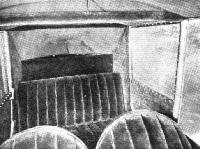Stinson Detroiter
В 1926 году пилот Эдди Стинсон для постройки четырехместного биплана с закрытой кабиной создал компанию "Stinson Aircraft Syndicate". Самолет, разработанный совместно Стинсоном и Альфредом Вервиллем, получил обозначение SB-1 Detroiter и в варианте прототипа оснащался системой обогрева кабины, шасси с индивидуальными (раздельными) тормозами и 220-сильным двигателем Wright J-5 Whirlwind, запуск которого выполнялся при помощи электростартера.
<...>
Показать полностьюShow all
Flight, May 1926
THE STINSON-DETROITER
An American Commercial Cabin 'Plane
ONE of America's pioneer air pilots, Edie Stinson, has recently produced a rather interesting commercial aeroplane which, besides possessing several novel features, also has a very good performance. This machine is a tractor fuselage biplane intended for commercial work, and is provided with an extremely comfortable totally-enclosed cabin accommodating four persons, including the pilot. Among the unusual features of this machine may be mentioned the fitting of brakes on the wheels for bringing the machine quickly to rest, and an electric self-starter ("Bijur") for the engine.
The development of this machine is the result of many years of flying experience on the part of its designer, for Edie Stinson's flying experience extends over fifteen years, during which time he has spent over 11,000 hours in the air. In designing the Stinson-Detroiter three main points were kept in mind. First to produce a machine which would be as safe as possible, secondly, it was to possess the maximum of comfort for pilot and passengers, and last but not least the design was to be such as to lend itself to production requirements.
For the owner-pilot this machine is admirably fitted, with its electric starter, and luxuriously-upholstered and heated cabin complete with carpet and cigar-lighter. Test flights have shown that the machine is very easy to fly, and has ample control - it having been flown for long periods with hands and feet off the controls.
The Stinson-Detroiter has been designed and constructed to conform to the latest provisions of the American Aeronautical Safety Code. It is constructed of welded steel tubing throughout, with the exception of the wing spars, which are of heavy spruce, and is in fact, practically speaking, an all-metal job. The ribs are built up of duralumin. The wings are of comparatively thick section (U.S.A. 35B), and are of equal span and chord with single bay bracing. The whole structure is fabric covered, thus greatly reducing the cost of construction. Ailerons are fitted to both top and bottom planes.
The fuselage is of rectangular cross-section, enlarged in the neighbourhood of the wings to form the cabin. The latter is provided with large windows in the sides and in front - the fuselage immediately in front of the cabin being of reduced depth - so that a really excellent range of vision is provided. When landing, it is possible for the pilot to look directly over the leading edge of the lower plane, while the wheels of the undercarriage are also visible. Access to the cabin is by way of a door on the left-hand side of the cabin.
At the rear of the cabin is a seat, facing forward, for two passengers, and in front are two seats side by side for pilot and a third passenger. Dual control is provided, the ailerons being actuated by the rotation of wheels mounted on the dash, while the elevators are operated by pushing the wheel forward or backward, through the dash. The rudder is operated by a foot-bar, on which is also mounted pedals for actuating the brakes.
Each landing wheel is provided with a brake, and the brakes can either be operated independently or simultaneously; it is possible to operate the rudder and the brakes together, the one assisting the other and rendering ground manoeuvring very easy. An unusual feature of this brake gear is the provision of anti-skid chains on the landing wheels, which have been found to be very effective (if not necessary) when the ground is covered with snow. The employment of wheel brakes not only enables the machine to be pulled up within a 100-ft. run, but when commencing a flight they serve to check the machine from bounding forward when the engine is started up or is being given its preliminary warm up - thus dispensing with the necessity for chock-blocks. When operating the machine single-handed this is an obvious advantage.
A large balanced rudder is provided, the vertical fin being adjusted to counteract the slipstream effect from the airscrew. The horizontal tail plane is adjustable as to incidence by means of a lever on the left-hand side of the pilot's seat.
The landing gear - which is located well forward in order to prevent the machine from turning over when the brakes are applied - is of the split axle type, and is of strong construction.
A 200 h.p. Wright "Whirlwind" radial air-cooled engine is employed, carefully streamlined into the fuselage by cowling. The exhaust is carried below the fuselage so that there is very little noise inside the cabin, where conversation between the occupants may be carried on without difficulty. A Curtiss-Reed metal airscrew is fitted.
If required the Stinson-Detroiter may be used for mail or freight carrying, there being space available for a 300 lbs. load in addition to the three passengers. This machine was built by the Stinson Airplane Syndicate of Detroit (Mich.), and the Syndicate is now being turned into a company for producing the machine in quantity.
The main characteristics of the Stinson-Detroiter are :-
Span 33 ft. 9 ins.
Chord 6 ft. 0 ins.
O.A. length 28 ft. 0 ins.
Wing area 350 sq. ft.
Dihedral angle (bottom) 4°
Angle of incidence 0°
Weight empty 1,700 lbs.
Useful load 1,200 lbs.
Speed range 45-125 m.p.h.
Petrol capacity 76 gallons.
Oil capacity 7 1/2 gallons.
Cruising range 500 miles.
Показать полностьюShow all




